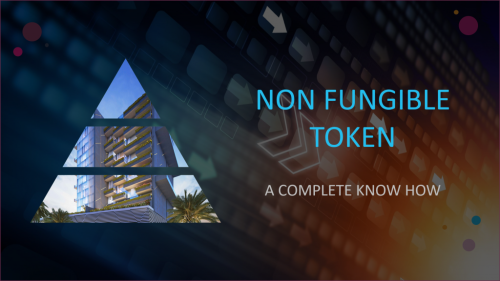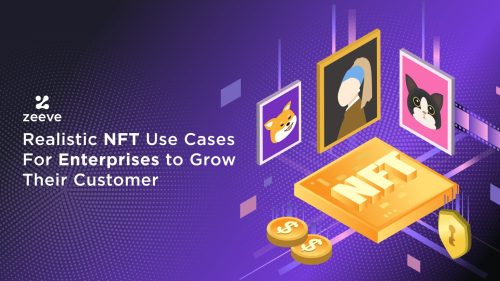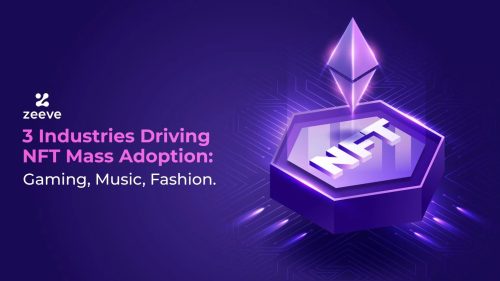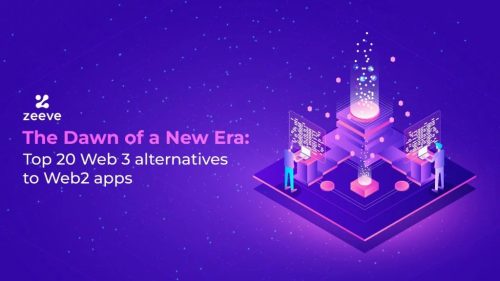
A Simple and Comprehensive Guide on Non-Fungible Tokens
Whether it is the rise of fintech or e-commerce, digitalization has played its part in improving accessibility for assets and enabling the frictionless transfer of value over the Internet. However, the current system still lacks credibility.
Any user buying a branded item, on the Internet or offline, is always concerned about its origin. For instance, buying a diamond from a nearby shop, a large retail store, or even from the Internet; the end customer can never be sure about its authenticity. More importantly, it is extremely difficult to establish the quality of the diamonds and then justify the cost by considering the factors such as the origin of the diamonds. When the diamond turns into jewelry and gets historic value, the need for credibility or origin increases exponentially.
Connecting this with other real-world assets such as art or collectibles makes it even more worthwhile to pursue the need for authenticity.
Enter NFTs
If you wanted to buy Mona Lisa, you can never be sure if it is the same Mona Lisa as painted by Leonardo da Vinci. There is a high probability of the original Mona Lisa being replaced with a fake. Even if it goes through extensive verifications, no one except Leonardo da Vinci can provide the much-needed credibility for the painting being original.
A major reason behind this is the fact that the painting has been bought and sold numerous times and it has been impossible to track the original one. Even certain attributes of the painting have changed with time and there is no way of establishing the authenticity of the original painting.
What if, there existed a digital record where Leonardo da Vinci himself provided the necessary description or characteristics to identify the original painting?
A digital record, where the ownership of the painting can be traced back to its origin, establishing trust among the buyers and creating a transparent environment for the valuation of the painting. Moreover, this digital record could be referred by any of the buyers to establish the authenticity of the painting by verifying the defined characteristics.
This is what Non-fungible tokens do.
The first step for understanding NFTs is realizing the fact that NFT is a token, representing an asset that is Non-Fungible. There are two concepts here — the first is tokenization on Blockchain and the second is an asset with the property of non-fungibility.
Fungible VS Non-Fungible Tokens
At a broad level, assets are of two types; fungible and non-fungible.
Fungible assets are those that can be interchanged because they possess similar properties. For example, if you own one bitcoin, it hardly matters which bitcoin it is because every bitcoin has the same value. Similarly, if you consider a real-world asset like the tire of your car, all 4 tires are the same. If you change the position of those tires or replace one of them with a new tire, it will make no difference.
Another thing to consider here is that every tire, of a particular size and company, is going to have the same value which simplifies the process of exchanging the tire. Trading such assets has been further simplified with the advent of digitalization.
At the same time, trading unique assets has become extremely difficult.
Sending or receiving money or cryptocurrency on the Internet is not that difficult but what if you want to send or receive the ownership to maybe an MP3 file that you created. Such an asset is non-fungible.
Non-fungible assets, on the other hand, can not be interchanged.
Another suitable example of a Non-fungible asset is diamonds. Each diamond has unique properties in terms of size, shape, color, cuts, and shine. Therefore, each diamond carries a different value based on such properties.
When it comes to representing non-fungible assets on the Internet, it is not as straightforward as representing a fungible asset. For instance, the origin of a non-fungible asset plays a huge role in defining its authenticity and value whereas the origin of a fungible asset is not that important as they carry the same value. Another aspect is the credibility of a non-fungible asset being original.
This is where Non-Fungible Tokens revolutionise asset digitalization.
What are NFTs
Using NFTs, a unique asset can be represented on top of a Blockchain network carrying some unique properties and a defined value. Tokens on Blockchain are used to represent the ownership of an asset which can be physical or digital. Transferring these tokens represents the transfer of ownership of the asset rather than the asset itself.
Considering the diamond example again, each diamond can be represented on the Blockchain network using NFTs. When an NFT is sold, the ownership of the diamond in the physical world is transferred to the buyer. In essence, the diamond can be in the mines and still be tradable in an authentic way.
These NFTs are stored on the immutable ledger of Blockchain. Therefore, the data belonging to the NFTs stays on the Blockchain forever and can be referenced any time for audits or any other purpose.
Characteristics of NFTs
Indivisible
NFTs can not be divided into smaller parts unlike the fungible assets such as a 20 dollar note that can be divided into smaller units. There is a concept of partial ownership that is often confused with subdividing the NFTs but in essence, partial ownership is owning a particular part of the NFTs.
Indestructible
The actual asset may be destroyed but the corresponding data of that asset that exists in Blockchain’s immutable ledger is indestructible. Therefore, the asset itself stays in the Blockchain’s record for as long as the Blockchain is there. A suitable example to understand this would be buying a ticket to a movie. The ticket is destroyed after the event is over but the record of who bought the ticket will always be there in the ledger.
Proof of ownership
During the creation of an NFT, the origin of the asset gets embedded into the Blockchain ledger which provides proof of ownership. Therefore, even if a ticket is bought and sold a hundred times, the latest owner can always verify the origin of the ticket and be sure about its authenticity.
Platform-specific
Currently, there are multiple Blockchain platforms that allow the creation of NFTs which is why NFTs have become platform-specific. More details on this are provided in the next section.
Different platforms for creating NFTs
As mentioned before, NFTs are created on top of a Blockchain platform. Therefore, there are different Blockchain platforms that can be used to create NFTs. These NFTs are specific to the platform used and hence non-interchangeable meaning that an NFT on Blockchain platform A can not be transferred to Blockchain platform B.
Mentioned below are the most popular Blockchain platforms currently being used for NFT creation:
Ethereum
Ethereum is the most popular Blockchain platform for the creation of NFTs. The first NFT in the world, CryptoPunks, was created on Ethereum. Since then, there has been an exponential growth in the Ethereum NFT space. Therefore, Ethereum has the biggest marketplace for NFTs. Projects such as Opensea and Rarible are part of the Ethereum NFT ecosystem.
NFTs created on the Ethereum Blockchain can belong to the smart contract standards ERC721 and ERC1155.
There are certain drawbacks too in the Ethereum ecosystem which include a high gas fee for transactions and network congestion leading to low scalability. There is a possibility of these drawbacks being eradicated with the advent of Ethereum 2.0 but that is not expected anytime soon. Another possible solution is developing NFTs on layer 2 solutions such as Matic.
Flow Blockchain
Flow is one of the most prominent Blockchain platforms for NFTs. Developed by Dappers lab, Flow Blockchain provides a more suitable atmosphere for NFTs free from network congestion and high transaction fees. Flow also provides NFT specific features which make the NFT creation process more streamlined.
The smart contract language for creating NFTs on the Flow Blockchain is Cadence. One of the most popular projects on Flow is NBATopShots which has gained immense popularity in the NFT domain.
WAX Blockchain
WAX has been built specifically for accommodating NFTs, providing a sustainable ecosystem. WAX has introduced vIRLsTM which allows consumer product companies to bridge the gap between the real and digital world by linking the NFTs with physical goods.
The smart contract language used for creating NFTs on WAX Blockchain is C++. Being one of the popular and most used programming languages, C++ has allowed a considerable community growth of WAX.
Algorand
Another upcoming Blockchain platform gaining immense popularity in the public domain, Algorand, also provides the facility of creating NFTs.
Algorand uses a pure Proo-of-Stake consensus algorithm which allows it to combat the Blockchain trilemma of Security, Scalability, and Decentralization. Therefore, it offers an advanced platform for the creation of NFTs. Languages supported by Algorand are TEAL and PyTEAL.
Other Blockchain platforms for NFT creation are Tron Blockchain, Binance Smart Chain, Polkadot, Tezos, and Cosmos.
Zeeve Tokenization Service
Zeeve is the leading Blockchain as a Service platform helping enterprises and Blockchain startups build, deploy and manage reliable decentralized apps and Blockchain networks. Zeeve is a low code automation platform that is cloud agnostic and supports multiple Blockchain protocols with advance analytics and monitoring of nodes and networks. Zeeve features a powerful set of APIs to build DApps for plethora of use cases across industries. One of the most popular Zeeve service is Zeeve Tokenization Service that helps build and deploy fungible and non-fungible tokens on cross chain protocols. The service has been used by 10+ customers to tokenize assets worth billions of dollars. From tokenization to building full fledged NFT Marketplace, Zeeve Tokenization service helps you build robust and scalable application with faster time to market. For more details, schedule a free call with our Tokenization specialist.







Responses